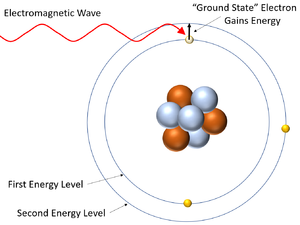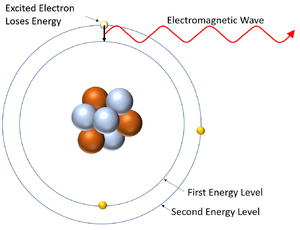Difference between revisions of "Energy Level"
(Created page with "==Key Stage 4== ===Meaning=== '''Energy Levels''' are another name for the electron shells or orbitals around the Atomic Nucleus|nucl...") |
|||
| Line 19: | Line 19: | ||
|} | |} | ||
| − | : If an [[electron]] in an '''energy level''' gains enough [[energy]] it can leave the [[atom]] completely so they [[atom]] becomes a [[Positive Ion|positive]] [[ion]]. | + | : If an [[electron]] in an the highest '''energy level''', known as the [[Outer Shell|outer shell]], gains enough [[energy]] it can leave the [[atom]] completely so they [[atom]] becomes a [[Positive Ion|positive]] [[ion]]. |
Revision as of 09:11, 7 March 2019
Key Stage 4
Meaning
Energy Levels are another name for the electron shells or orbitals around the nucleus where electrons can exist.
About Energy Levels
- The existence of energy levels in atoms is part of the Bohr model of the atom.
- The electron orbitals in atoms each correspond to electrons with a certain amount of energy, which is why they are also called energy levels.
- Electrons cannot exist anywhere between the energy levels they can only exist in one energy level or another.
- In chemistry electrons are seen as fixed in their energy levels but in physics the electrons can move to a higher energy level by the absorption of energy and can drop down into an empty energy level below by emitting energy.
- The wavelengths of electromagnetic wave depend on the energy difference between the energy levels in atoms.
| This diagram shows an electron gaining energy by absorbing an electromagnetic wave and moving to a higher energy level (becoming excited). | This diagram shows an excited electron losing energy by emitting an electromagnetic wave. As it does this the electron falls back down to a lower energy level. |

